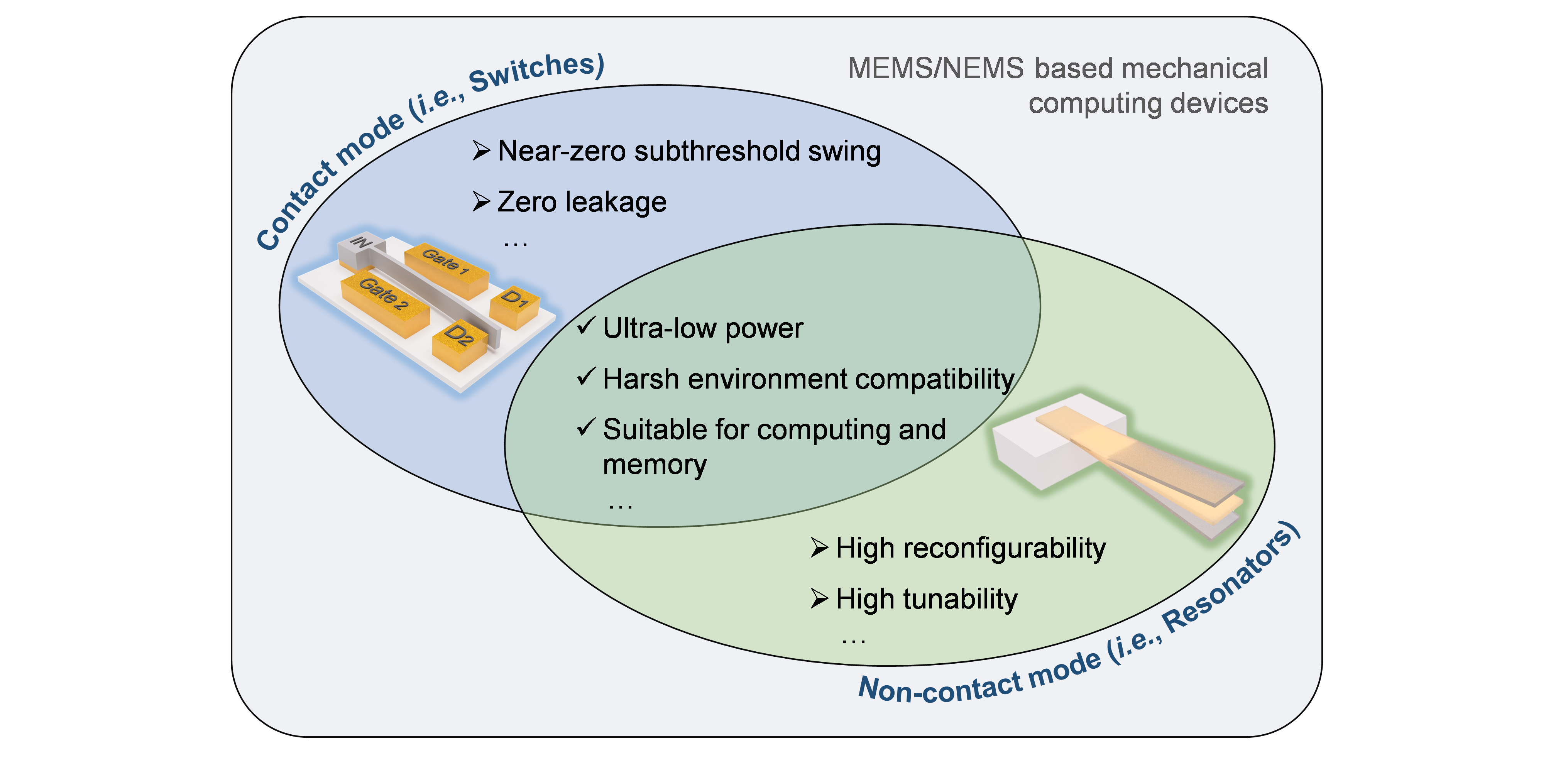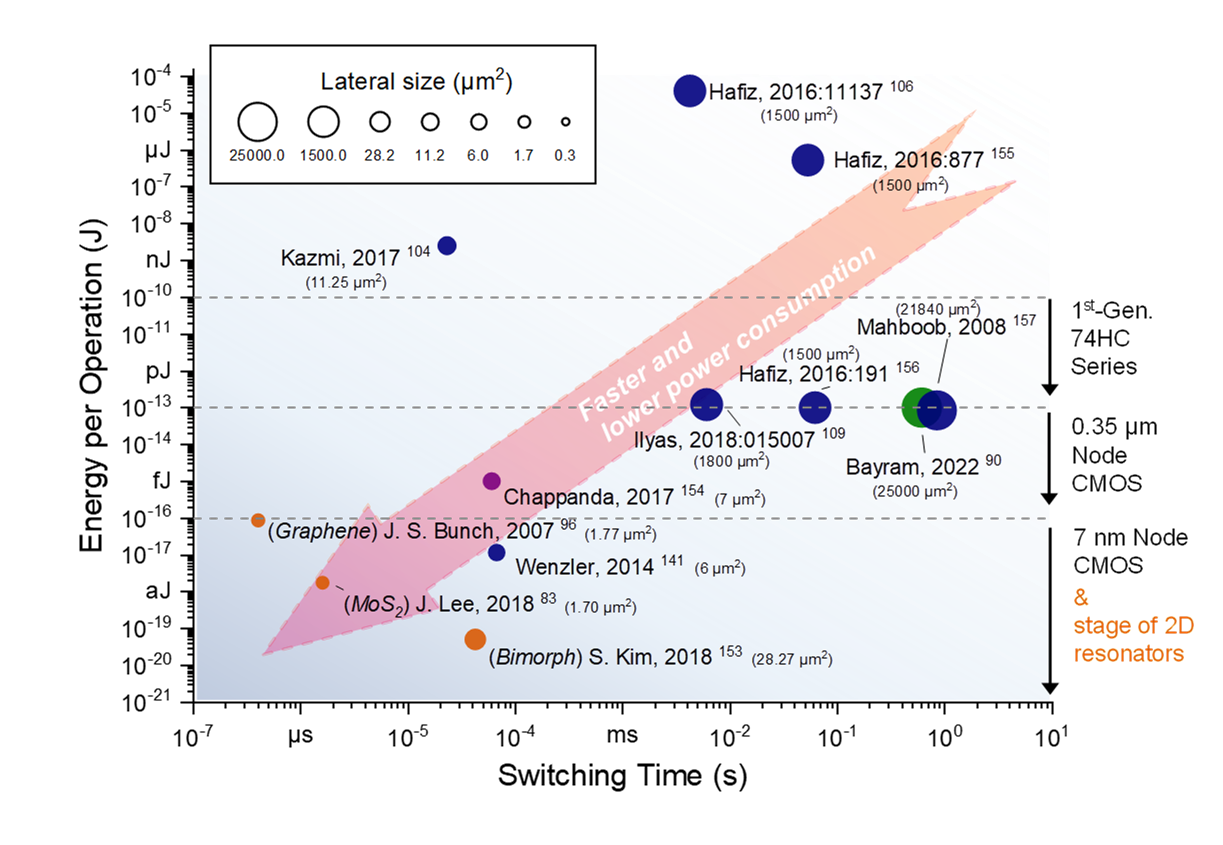Chip发表电子科大王曾晖-上海交大杨睿团队合作综述论文:片上机械计算——成果、挑战和机遇
FUTURE远见| 2023-03-30
Future|远见
Future|远见future选编
FUTURE | 远见 闵青云 选编
本综述全面介绍了基于片上微纳机电系统的下一代存储和计算器件,包括它们的运作机理、最新研究进展、重要挑战及未来应用前景。
我国宋朝第一次发明了机械计算设备。而后在1642年,Pascal发明了可以进行加减法的计算器。在1822年,Charles Babbage发明了融合计算和存储功能的差分机,这相比于冯·诺伊曼发明现代电子计算机架构提早了一个多世纪。在20世纪初至中叶,机械计算机的应用达到其巅峰,其广泛用于弹道计算、加密和解密等。现代微纳加工技术使这些高度集成的精巧机械器件处于完全不同的尺度,有望使其焕发新的活力:伴随着近年来不断涌现的研究成果,这些微纳机电器件有望构筑全新的片上机械计算范式。微纳机电系统(MEMS/NEMS)赋能的片上机械计算正在下一代存储计算器件解决方案中展现出独特的潜力²。
MEMS/NEMS充分利用固态器件中的机械自由度巧妙地实现逻辑计算与存储功能,与基于电子迁移的晶体管等器件原理不同,它们能够有效避免电子器件中的短沟道效应和高温产生的载流子的影响³,有利于实现极低功耗、适应恶劣环境和可重构性强的存储计算器件。片上机械计算器件主要分为两类,即接触式微纳机电开关和非接触式微纳机电谐振器件(图1)。本综述分别详细介绍了这两种片上机械计算器件的工作原理、发展现状、重要挑战以及未来发展方向和前景。

图1 | 微纳机电计算器件特性总结¹。左图为一单刀双掷纳机电开关;金色部分表示金属电极,灰色部分表示运动部件;右图为一悬臂梁纳机电谐振器。
文章首先介绍接触式微纳机电存储计算器件,亦称为微纳机电开关或继电器。文章介绍了其经典器件结构和控制机理,包括以直接联通方式实现高电导率的开态、以间隔气隙断开方式实现无穷小漏电流的关态、以对称栅极实现三态门、以四终端结构实现互补逻辑等,具备极低亚阈值摆幅、高鲁棒性(尤其是支持高温应用)、趋近于零的截止状态漏电流等独特优势。随后,文章还讨论了接触界面粘附性、低电压可操控性、低功耗逻辑电路、高温环境适应性、器件设计灵活性、静态双/多稳态等方面的成果,以及在优化驱动电压、器件速度和寿命等方面的挑战。
非接触式微纳机电谐振器包含丰富的机械自由度⁴,支持通过指定频率振幅等方式实现逻辑功能、以非线性双/多稳态实现存储功能和作为神经形态计算单元等,其具备很好的可重构性、很高的可调谐性、极低的功耗等关键优势。文章在概述器件结构和机理后,讨论了谐振频率调谐技术(这是逻辑信号与谐振相耦合的桥梁)、谐振式可重构计算器件、谐振式存储器⁵、谐振式神经形态计算器件,以及量子计算等纳机电计算前沿。文章还总结了该类器件的代表性研究成果中关键器件性能的缩放与发展规律(图2,文章中另含详细参数表),显示了低维纳机电谐振器的应用潜力。

图2 | MEMS/NEMS谐振器部分代表性研究成果的器件性能(速度、能耗和面积)概要图。圆标记点的直径表示器件面内尺寸,其颜色表示器件类别:蓝色是双端固支梁型,绿色是微悬臂梁型,紫色是纳悬臂梁型,橙色则是基于二维材料的谐振器。图中所涉及具体数据请见原文¹。
最后,本文一并讨论了片上纳机械计算面临的关键挑战。通过将单元性能与主流器件进行对比,还对该领域备具前景的发展方向提出展望。
On-chip mechanical computing: status, challenges, and opportunities¹
The on-chip mechanical computing devices enabled by micro- and nano-electromechanical systems (MEMS/NEMS) have been demonstrating the unique potential for next-generation memory and computing². MEMS/NEMS utilize the mechanical degrees of freedom to achieve computing and memory functions, which are different from transistors, and can avoid the short-channel effects and heat-induced carriers³. These devices possess key advantages such as extremely-low power consumption, robustness for harsh environments, and high reconfigurability. There are mainly two categories of on-chip mechanical computing devices: contact-mode MEMS/NEMS switches, and non-contact-mode MEMS/NEMS resonators. This review provides an in-depth overview of the working principles, challenges, and future directions of mechanical computing devices. Mechanical computing devices started several decades ago from the Song dynasty, and modern nanofabrication techniques have enabled highly integrated and delicate mechanical devices with ever smaller scales and more functionalities. They are experiencing a resurgence in research, holding the potential to establish a new computing paradigm.
This review first introduces contact-mode MEMS/NEMS computing and memory devices, which are also called MEMS/NEMS switches or relays. These devices can achieve high ON-state conductivity through direct electrical contact, infinitesimal OFF-state leakage through inter-electrode air/vacuum gap, three-state logic gate through symmetric electrode design, and complementary logic through four-terminal structure, etc. These devices show unique advantages such as extremely low subthreshold swing, high robustness (especially for high-temperature applications), and near-zero leakage. The discussion also includes adhesion between contacting surfaces, low-voltage operation, low-power MEMS/NEMS logic circuits, high-temperature compatibility, reconfigurable devices, static bi-/multi-stability, as well as the challenges and prospects for optimizing the actuation voltage, speed and lifetime.
Non-contact MEMS/NEMS resonators have considerable mechanical degrees of freedom that can be utilized to achieve logic functions⁴.These devices have high reconfigurability, high tunability, and ultralow power consumption. After outlining the device structures and their working mechanisms, this section discusses resonance frequency tuning, resonator-based reconfigurable computing, resonators for memory⁵, resonators for neuromorphic computing, and emerging NEMS computing such as quantum computing. This review also summarizes the scaling trends of key device performance (as shown in Fig. 2, with detailed parameters summarized in the main text), demonstrating the high potential of using low-dimensional materials for resonator-based computing.
This review concludes by discussing the major challenges and perspectives for modern MEMS/NEMS computing devices.
参考文献:
1. Wang, L., Zhang, P., Liu, Z., Wang, Z. & Yang, R. On-chip mechanical computing: status, challenges, and opportunities. Chip 2, 100038 (2023).
2. Wang, Z., Fang, J., Zhang, P. & Yang, R. Nanomechanics: emerging opportunities for future computing. Sci. China Inf. Sci. 64, 206401 (2021).
3. Theis, T. N. & Wong, H.-S. P. The end of Moore’s law: a new beginning for information technology. Comput Sci Eng 19, 41–50 (2017).
4. Xu, B. et al. Nanomechanical resonators: toward atomic scale. ACS Nano 16, 10 (2022).
5. Wang, Z., Yang, R. & Feng, P. X.-L. Thermal hysteresis controlled reconfigurable MoS₂ nanomechanical resonators. Nanoscale 13, 18089–18095 (2021).
论文链接:
https://www.sciencedirect.com/science/article/pii/S2709472323000011
关于Chip
Chip是全球唯一聚焦芯片类研究的综合性国际期刊,已入选由中国科协、教育部、科技部、中科院等单位联合实施的「中国科技期刊卓越行动计划高起点新刊项目」,为科技部鼓励发表「三类高质量论文」期刊之一。
Chip期刊由上海交通大学与Elsevier集团合作出版,并与多家国内外知名学术组织展开合作,为学术会议提供高质量交流平台。
Chip秉承创刊理念: All About Chip,聚焦芯片,兼容并包,旨在发表与芯片相关的各科研领域尖端突破性成果,助力未来芯片科技发展。迄今为止,Chip已在其编委会汇集了来自14个国家的70名世界知名专家学者,其中包括多名中外院士及IEEE、ACM、Optica等知名国际学会终身会士(Fellow)。
Chip第二卷第一期(2023年春季刊)于2023年03月在爱思唯尔Chip官网以金色开放获取形式(Gold Open Access)发布,欢迎访问阅读文章。
爱思唯尔Chip官网:
https://www.journals.elsevier.com/chip




